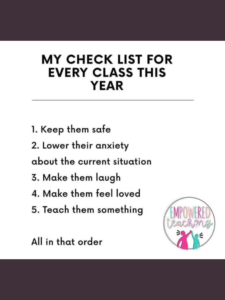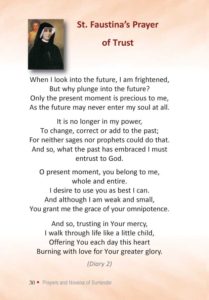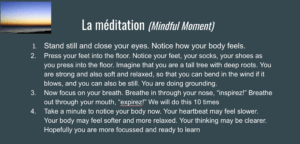WARNING: This is a very long blog post (totally against common sense for what makes a blog effective, successful, and useful) and you’ll be entering the thoughts of an overthinking introvert. Then again, my blog is selfishly a way for me to process my thoughts and, for better or worse, I process those thoughts slowly. Sometimes when you can’t find the words to express your thoughts and someone else does, it might help in some small way to make you feel like you’re a little less alone if you connect. Hopefully you get something out of it, but if not, there are many more polished and professional blogs out there!
Will your anchor hold in the storms of life,
When the clouds unfold their wings of strife?
When the strong tides lift, and the cables strain,
Will your anchor drift or firm remain?
-Priscilla Owens (1829)
I really struggled with finding the motivation and the topic of this initial blog for Season 9 of Cohort 21. I feel like I’m in “un état de survie” most of the time. Two years and six months ago was my last blog entry and it was entitled How Lovely are Thy Dwelling Places. It focussed on what I thought were (and what I still think are) essential ingredients for infusing joy into education: beauty, vocation, forgiveness, and imagination. My, how life and the world have changed since that post! Through a current event and personal reflection on my practice as an educator, I came to the conclusion that the most important action I can do in education at this moment in time is simply to be steady, to be fully present, and to be an anchor in a world that demands pivoting (pirouetting?) which pulls me in so many directions. I will share what brought me to this conclusion and the strategies I am using to hopefully be this anchor for my students.
Two weekends ago, I was at the family farm. My 85 year old mom woke up late on Halloween night as she smelled smoke and heard the sound of sirens. She unarmed the security system and looked out towards our barn, towards our machinery shed, and then towards my brother’s house across the road, but she could not see a fire. By that time, I was up from my bedroom in the basement and we looked out from the side door towards the small yellow brick church that has stood beside the farm since 1895. We were confronted with the traumatic sight of this House of God engulfed in flames, vicious tongues of fire bursting through the stained glass windows, and the ribs of the tower roof aflame like a huge torch against the night sky. This sight, these sounds, and those smells were heartbreaking and will haunt me for the rest of my life. Since some of the people of this small community have moved far and wide, there were several comments on a closed Facebook group sharing memories of this spiritual home, of the importance of community in a rural setting, and my cousin mentioned an often-sung and rousing hymn: Will your anchor hold in the storms of life? It was that “airlock seal moment” that made me realize what I am trying to do is to be an anchor for my students much like this church was for the community. At my school, the official motto is: crux mihi ancora veritas omnia vincit (the cross is my anchor, truth conquers all). In the past three years, we have sung that hymn at least once a year. An anchor forms part of the school crest. While I have to read the waves, be nimble, change, and adapt, I feel that, above all, I must be grounded. I have often said that I do not feel that I am an extraordinary or dynamic educator. I seek to be an ordinary, dependable, and steady educator who desires to connect with students on a humane level through the heart. What can this type of educator offer young people during our present unpredictable and turbulent times?
Over the summer, I did a lot of reflection on what had happened and what was to come.
As soon as we went remote last March, I moved my students to Google Classroom from the other learning management platform, and I imposed a structure that would seem unrelenting. I posted four short weekly tasks (listening, speaking, reading, and writing in French) on Mondays at 8 AM which were to be completed by Friday at midnight. My daily lesson always had the same structure through Pear Deck of asking how they were doing, sharing the learning goals, going over the Google Classroom assignments, a short grammar review, filling in the blank templates through either a shared Google Doc or Google Slide worksheet, alternating between Quizlet and Kahoot, asking how they felt at the end, and finally a Google Form exit ticket before reviewing the homework. The key to learning what worked or what didn’t was honest and open communication from the students. It was SO much work to establish a new order and teach myself all of the tech tools while the world seemed to be descending into the chaos of the unknown. Shout outs to my two Youtube educating heroes who were willing to share so openly: Sam Kary of the New EdTech Classroom (https://www.youtube.com/channel/UCd6vizTYlSgpR6zJ8j5KiyA) and John Sowash (https://www.youtube.com/user/jrsowash). They, with the support of the school’s Technology and Teaching Coach (Adam Caplan), literally saved my sanity and my life. I survived, so did my students, and we even seemed to find a bit of our own wind by the end of the academic year. Predictability and order seemed to help with success.
Over the summer, I continued to read about student depression, anxiety, and feelings of isolation and trepidation linked to the unknown of the future and the return to the physical schools. I held up at the farm during the break, focussed on gardening, and canning or freezing anything that didn’t move. I even tried my hand at becoming an Instagram Influencer, although with only 43 followers, I’d consider it a rather modest success, but you have to start somewhere, right?! I attended a lot of online professional development and several webinars. Due to my mom being at high risk for contracting coronavirus because of her age and health conditions, I only went off the farm for essential tasks such as grocery shopping at 8 AM on a Saturday morning (right after the seniors had finished). Obviously, transition to being back in the Big Smoke (a.k.a. Toronto), and in front of 12 students with 12 more at home, as the school implemented a hybrid model, created some panic. My bubble of 3 would, in a flash, explode into over 300. What to do?
Obviously, my first concern was creating connections and a psychologically safe learning environment. A friend shared a critical document called The First 10 Days of School and Beyond (https://smho-smso.ca/wp-content/uploads/2020/08/The-First-10-Days.pdf) and I started to think of how I could shape those first few days for myself and for my students. I saw such a great poster on Twitter entitled My Checklist for Every Class This Year. It made sense to me and I ran with it! I picked things from here and there to create order, routine, and rituals. I planned to read them some unique picture books so they could think about life lessons (Tiny T. Rex and the Impossible Hug by Jonathan Stutzman, The Cool Bean and The Good Egg by Jory John and Pete Oswald, Malala’s Magic Pencil by Malala Yousafzai and I later continued with a variety of Aesop’s Fables and courte métrages on Fridays).
The first day came and I was terrified and was on the verge of a panic attack when I thought about safety, about the huge responsibility, and about having to teach two separate courses to two cohorts of students in class and at home at the same time. The school decided on the Quadmester model, so I would teach the same subject to the same students for 3 hours a day from September until mid-November. I didn’t sign up for this, but ready or not, the first day came and the first cohort would be in front of me. I prayed St. Faustina’s prayer before class in order to calm my nerves and then walked into the unknown.
What happened? It was far from perfect, but the students were incredibly patient and forgiving of what I felt was ineptness on my part. Little by little, a gentle wind started to lift my sail ever so slightly. Little by little, we grew together, we helped each other out, and we became a community of learners. We created rituals: the daily grounding, breathing and tension release exercises (taken from Mindfulness for Anxious Kids by Catherine Cook-Cottone and Rebecca Vujnovic); my daily pledge to them, the incorporating of 5 a Day for exercise; the Church Block Walk, and the daily feedback through Pear Deck exit cards. It helped me to remember the essentials, and that breathing is life not only for them, but for me.
No, it wasn’t perfect because I wasn’t able to effectively figure out a way to use Breakout rooms to create community & I still haven’t become the most adept at teaching both in class and to students at home (or as I liked to refer to them, “Online School Sisters”), but I hope they know I was trying my best and that I genuinely cared about them. There’s still a lot of work to be done, but if I was anything to them, I hope I was steady and constant. I hope they felt that I was an anchor, particularly in the sea of the unknown. I hope they felt safe in my class.
As we come to the end of Quadmester 1, this means a new uncertainty awaits them and me. Chances are we won’t actually see each other again for a long time. It worries me a bit as I’ve come to care a lot about them because they’ve accepted my quirkiness and “rolled with it” , but as John A. Shedd once said, “A ship in harbour is safe, but that is not what ships were built for.” I still think being an anchor for the students in my subsequent classes this year will be key as it’s an authentic sharing of myself. I’ll also continue to be inspired by St. Teresa of Calcutta’s saying: “Not all of us can do great things, but we can do small things with great love.” While I think the anchor is holding fast, it’s also time to start thinking about adding to the journey, and also weighing my anchor ever so timidly in order to grow and help my students grow. Sometimes the choppy waves have a lot to teach us as well.
This is why I fell in love with Cohort 21 as it has forced me to reflect within a safe, supportive environment. I also learn from others through their blogging and don’t feel isolated and alone.
Anchors Aweigh, my boys, Anchors Aweigh!
Farewell to foreign Shores, we sail at break of day-ay-ay-ay;
Through our last night ashore, drink to the foam,
Until we meet once more, here’s wishing you a happy voyage home!
-Revised, 1997 by MCPON John Hagan, USN (Ret)






Très beau!
Merci beaucoup! 😉
@cobban Well said. You mention that you aim to be an anchor for your students, and I wonder how much the inverse is true. In many ways what anchors us is others; their anchors allow us to stay grounded and thus give us the opportunity to be anchors for others.
@Brandon Black. While I didn’t reply right away, I really appreciated your thoughtful comment. In fact, I think it deserved a whole blog reply!
@pcobban – you never have to apologize for a long blog post, it’s such a great one. You’re right that blogs are a way to process and for those who see it as too long… In the word’s of Seth Godin – “That’s ok, this is just isn’t for you.”
The right people are reading and learning and connecting, even if it’s a tad late. 🙂
Mieux vaut tard que jamais!